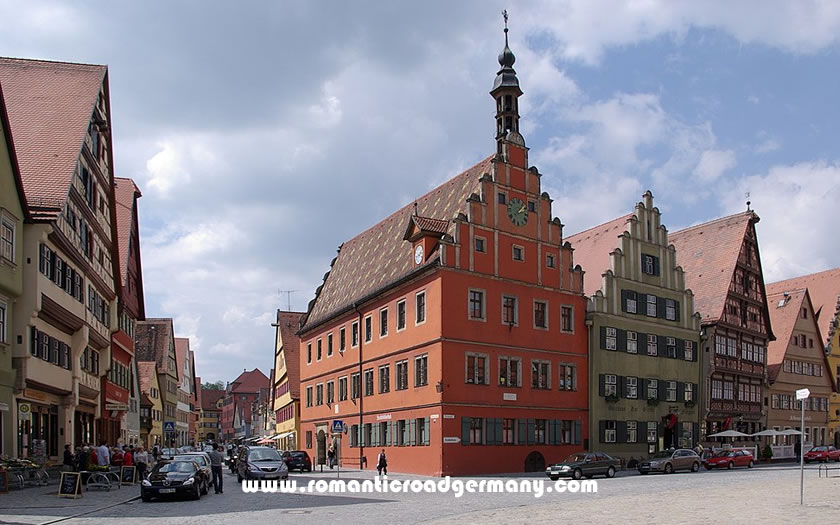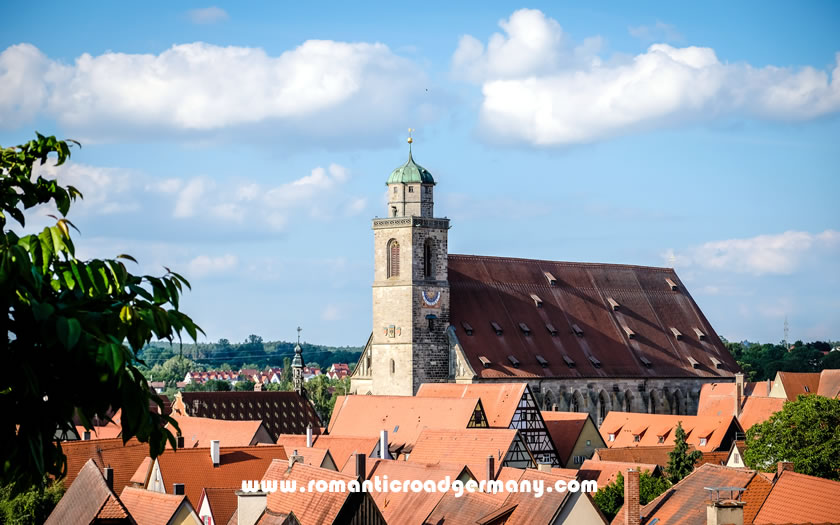

Dinkelsbühl is one of the archetypal towns which give the German Romantic Road its character.
Along with its two neighbours (Rothenburg to the north and Nördlingen to the south) it is one of the only remaining walled medieval towns in Germany and its imposing minster and the timbered buildings give visitors a strong impression of how the towns appeared in the Middle Ages.

The timbered walled town centre of Dinkelsbühl is one of the main sights on the Bavarian section of the Romantic Road between Rothenburg ob der Tauber and Nördlingen.
The town's foundation legend refers to a grain farmer ('Dinkel' means spelt in German). However, Dinkel is more likely a corruption of 'Thingolt', one of the first royal administrators, and 'bühl' is a common contraction for a hill or a hilly landscape.
Although it might look intimidating for foreigners, the pronunciation of Dinkelsbühl is not that difficult. The 'üh' in the last part of the word lengthens the vowel, in a similar way to 'buel'.
Dinkelsbühl is known for the 'Kinderzeche' - an annual festival which commemorates the surrender to the Swedish forces in the Thirty Years War and a child's plea which saved the town from destruction.
Dinkelsbühl is about two hours' drive northwest of Munich, via Augsburg and Donauwörth. It is possible to use public transport with a lengthy combination of trains and buses via Ansbach and Feuchtwangen.
The closest airports to Dinkelsbühl are located at Nuremberg, Stuttgart, Memmingen and Munich.
Distance to Nuremberg Airport: 108km
Distance to Stuttgart Airport: 140km
Distance to Memmingen
Airport: 151km
Distance to Munich Airport: 184km
Both Stuttgart and Munich are fairly important centres for scheduled flights for major airlines (Munich being the larger of the two). The other airports have varying degrees of options with internal flights or low-cost carriers.
Dinkelsbühl doesn't have its own current railway station - the nearest stations are located in Crailsheim (22km) or Ansbach (42km). There is a regular bus service from these stations. However on certain days in the summer there is a historic steam train run on the former line from Nördlingen to Feuchtwangen.
Dinkelsbühl is a fabulous town to stop off along the way on a journey down the Romantic Road. It is one of Germany's most "romantic" medieval towns and many of the hotels can trace their origins back to the days of the Middle Ages - as inns or merchants' houses or as storehouses.
As well as being an attractive town to wander through in the evening, Dinkelsbühl is also a good base to explore the towns in this part of Bavaria - Feuchtwangen, Ellwangen and Crailsheim are all worth a visit.
If you know when you are planning to go but haven't decided on accommodation, then use the map below to get an idea of which properties are available and to compare prices during the period you wish to travel.
Enter your proposed dates and use the '+' to zoom in on a location and reveal more properties. Click on the price above a property to see more information.
(Please note that this selection will also include some guesthouses, pensions and self-catering apartments for those who are interested in that form of accommodation!)
If you know when you are planning to go but haven't decided on accommodation, then use the searchbox below to get an idea of which properties are available and to compare prices during the period you wish to travel.
Dinkelsbühl stood at the junction of two very important trade routes - the north-south Germany-Italy route and the route from the Rhine towns through to Eastern Europe.
The town is thought to have been founded in the 8th century and the first official mention in documents (as "Tinkelspuhel") is in the 12th century when it already apparently had the right to hold a market.
The town became an Imperial free city and started work on the fortifications which still surround the historic centre in the 13th century.
The wealth of the town was built on weaving and cloth manufacturing and the trading guilds were at the forefront of efforts to extend the privileges of power (such as council membership) to the guilds and merchants.

In the Middle Ages, the town was rocked by the religious wars of the Reformation and Counter Reformation, with control over the town passing from Protestant to Catholic and back again a number of times. The majority of the population were Protestant but with the settlement in the 17th century of the Concordance of Equality Dinkelsbühl became a town where there are strict rules on the fair treatment of believers from both religions.
However, these wars, and industrial and economic changes in the production of clothing led to a period of decline for the town, which is one reason why so many of the old town walls and houses still stand. (People didn't have the money to build new properties which would have resulted in the demolition of older ones.)
Another reason for the current "look" was the decision of Ludwig I of Bavaria to safeguard the historic buildings and protect them from destruction in the early 19th century.
The festival of the "Kinderzeche" draws part of its content from the Thirty Years' War. The children's festival is held every year in July and purports to represent the rescue of the town from destruction by Swedish mercenaries by the intervention of the children of the town, led by the gatekeeper's daughter. It is also historically related to the feasts and excursions enjoyed by Catholic and Protestant schoolchildren at the end of the school year in the Middle Ages.
The Minster is the impressive and quite massive church at the historic heart of Dinkelsbühl.
The core of the current structure was built in the 15th century - adding on to older buildings that had existed in this area.
The tower of the church was originally not planned to be the church tower at all - it was a free-standing structure to the west of the main building which had been built in the 12th century.

However the ambitious plans for a tower at the northern end had to be put aside because of lack of money and the architects extended the church building to the old tower. The style of the main building is late Gothic.
The minster became popular with pilgrims in later centuries because of the highly-decorated altars inside the church. It is possible to climb the tower during weekend afternoons with good weather in the summer months.
The Dinkelsbühl Tourist Office is situated in the centre of the town in Marktplatz, in the Haus der Geschichte. It is open every day all year round.
Website: www.dinkelsbuehl.de